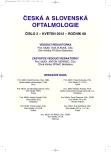Evaluation of Bacterial Colonization of the Conjunctival Sac in Ranibizumab Intravitreal Injections Treated Patients
Authors:
J. Studnička 1; J. Beránek 1; Lenka Ryšková 2
; E. Rencová 1; L. Hejsek 1; P. Rozsíval 1
Authors‘ workplace:
Oční klinika FN a LF UK, Hradec Králové, přednosta prof. MUDr. Pavel Rozsíval, CSc., FEBO
1; Ústav klinické mikrobiologie FN, Hradec Králové, přednosta doc. RNDr. Vladimír Buchta, CSc.
2
Published in:
Čes. a slov. Oftal., 68, 2012, No. 2, p. 51-55
Category:
Original Article
Overview
Aim:
To establish the conjunctival sac bacterial flora structure in patients with wet form of the age-related macular degeneration (ARMD) indicated for the intravitreal application of Ranibizumab (Lucentis, Novartis Pharma AG). To evaluate the efficacy of combined local preparation with broad-spectrum antibiotic moxifloxacine 0.5 % (Vigamox, Alcon) and povidone iodine solution, 5 % (Betadine, Egis Pharmaceuticals, LTD.) and to evaluate subjective toleration of moxifloxacin.
Materials and methods:
In a prospective, non-randomized study were evaluated 20 eyes of 20 patients treated by means of intravitreally-applied ranibizumab. In all patients, the swabs from the conjunctival sac of the treated eye were repeatedly taken in a given time-schedule – before the start of using moxifloxacin, on the day of the intravitreal application of ranibizumab – before the irrigation of the conjunctival sac with povidone iodine solution, 5 %, further after the irrigation - immediately before the injection and the control was taken three days after the intravitreal injection. At the same time, the moxifloxacine toleration was evaluated by a questionnaire.
Results:
The samples taken from the conjunctival sac of the treated eye before the application of moxifloxacine had positive bacterial culture in 17 eyes (85 %) and negative culture in 3 eyes (15 %). Furthermore, in 2 eyes with positive culture, there was established resistance to moxifloxacine. After 3 days of moxifloxacine application, there was negative culture in 13 eyes (65 %), in 7 eyes (35 %) was the bacterial cultivation positive. After the irrigation with povidone iodine 5 % solution was the cultivation negative in 17 eyes (85 %), positive cultivation was in 3 eyes (15 %); in all three cases, the cultures were susceptible to moxifloxacine. Three days after the intravitreal injection, the negative cultivation from the conjunctival sac was found in 13 eyes (65 %), and in 7 eyes was the cultivation positive; the cultivated bacteria were moxifloxacine susceptible. Subjective symptoms after moxifloxacine application were reported by 10 patients altogether; 5 patients were without symptoms and 5 patients did not return the questionnaire. On average, the symptoms started the second day of moxifloxacine treatment and the average grade of symptoms was 1.6 on the scale from 0 to 5.
Conclusion:
In our group we found a broad spectrum of microorganisms colonizing the conjunctival sac of patients indicated to the ARMD intravitreal treatment. After the prophylaxis with moxifloxacine, the incidence of positive bacterial cultivation decreased and the povidone iodine 5 % solution irrigation this effect increased. The most common pathogen species was Staphylococcus coagulasis negative. Although the resistance to moxifloxacine in two different bacteria in two eyes in the beginning of observation was established, after moxifloxacine treatment, the cultivation of these bacteria in both eyes was negative, and in all other cases the cultivated bacteria were susceptible to moxifloxacine.
Key words:
resistance, susceptibility, moxifloxacine, povidone iodine
Sources
1. Bhavsar, A.R., Googe Jr., J.M., Stockdale, C.R. et al.: Risk of endophthalmitis after intravitreal drug injection when topical antibiotik are not required. Arch Ophthalmol, 2009; 127: 1581–1583.
2. Brown, D.M., Kaiser, P.K., Michels, M. et al.: Ranibizumab versus Verteporfin for Neovascular Age-Related Macular Degeneration. N Engl J Med, 2006; 355: 1432–1444.
3. Donnenfeld, E., Perry, H.D., Chruscicki, D.A. et al.: A comparison of the fourth-generation fluoroquinolones gatifloxacin 0.3% and moxifloxacin 0.5% in terms of ocular tolerability. Curr Med Res Opin, 2004; 20: 1753–1758.
4. Halachmi-Eyal, O., Lang, Y., Keness, Y. et al.: Preoperative topical moxifloxacin 0,5% and povidone-iodine 5% versus povidone-iodine 5% alone to reduce bacterial colonization in the coinjunctival sac. J Cataract Refract Surg, 2009; 35: 2109–2114.
5. Honda, R., Toshida, H., Suto, Ch. et al.: Effect of long-term treatment with eyedrops for glaucoma on conjunctival bacterial flora. Infection and Drug Resistance, 2011; 191–196.
6. Kim, S.J., Toma, H.S.: Ophthalmic antibiotics and antimicrobial resistance. Ophthalmology, 2011; 118: 1358–1363.
7. Moss, J.M., Stanislo, S.R., Ta, C.N.: A prospective randomized evaluation of topical gatifloxacin on conjunctival flora in patients undergoing intravitreal injections. Ophthalmology, 2009; 116: 1498–1501.
8. Perkins, R.E., Kundsin, R.B., Pratt, M.V. et al.: Bacteriology of normal and infected conjunctiva. J. Clin. Microbiol., 1975; 147–149.
9. Rosenfeld, P., Brown, D. M., Heier, J. S. et al.: Ranibizumab for Neovascular Age-Related Macular Degeneration. N Engl J Med, 2006; 355: 1419–1431.
10. Shah, Ch.P., Garg, S.J., Vander, J.F et al.: Outcomes and risk factors associated with endophthalmitis after intravitreal injection of anti-vascular endothelial growth factor agents. Ophthalmology, 2011; 118: 2028–2034.
Labels
OphthalmologyArticle was published in
Czech and Slovak Ophthalmology

2012 Issue 2
Most read in this issue
- Repeatability and Reliability of the Visual Acuity Examination on logMAR ETDRS and Snellen Chart
- Acute Retinal Necrosis
- The Diabetic Macular Edema – New Possibilities of the Treatment
- Evaluation of Bacterial Colonization of the Conjunctival Sac in Ranibizumab Intravitreal Injections Treated Patients
